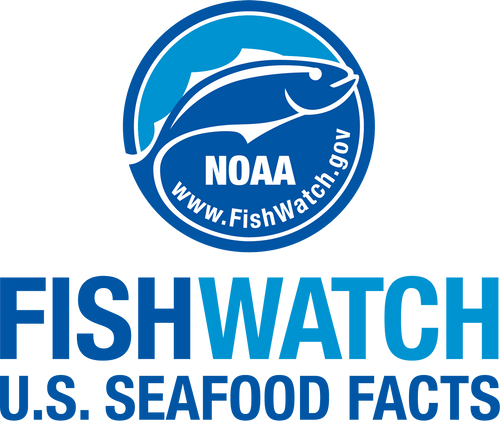 Pacific halibut. Credit: NOAA Fisheries
Pacific halibut. Credit: NOAA Fisheries
Pacific halibut. Credit: NOAA Fisheries
About the Species
 Pacific halibut. Credit: NOAA Fisheries
Pacific halibut. Credit: NOAA Fisheries
Pacific halibut. Credit: NOAA Fisheries
Pacific halibut is the largest species of flatfish. It is native to the North Pacific Ocean and it is fished by commercial, recreational, and subsistence fishermen. Huge Pacific halibut, sometimes called "barn doors," can attain a length of more than 8 feet and a width of more than 5 feet. Halibut are born swimming like salmon, with eyes on either side of their head. As they grow (by the time they are 6 months old), one eye migrates to the right side and the young halibut begin swimming sideways, with both eyes on the top of their bodies. Their large size and delectable meat make them a popular and prized target for both sport and commercial fishermen.
U.S. wild-caught Pacific halibut is a smart seafood choice because it is sustainably managed and responsibly harvested under U.S. regulations.

Population
The stock is not overfished.

Fishing Rate
Not subject to overfishing.

Habitat Impact
Fishing gears used to harvest Pacific halibut have minimal impacts on habitat.

Bycatch
Regulations are in place to minimize bycatch.
Population Status
- According to the 2020 stock assessment, Pacific halibut is not overfished and is fished at the recommended level that is set by the International Pacific Halibut Commission. Summary stock assessment information can be found on Stock SMART.
Appearance
- Pacific halibut have flat, diamond-shaped bodies.
- They swim sideways, and the upper side is typically mottled gray to dark brown, which helps them blend in with sandy or muddy bottoms. Their underside is typically white.
- Both of their eyes are on the upper side of their body.
- Their scales are small and buried in the skin, giving them a smooth appearance.
Biology
- Pacific halibut are one of the largest flatfish—they can weigh up to about 500 pounds and grow to more than 8 feet long.
- Males tend to be smaller than females.
- Males sexually mature when they are 8 years old, and females are able to reproduce by the age of 12.
- They spawn during the winter in deep water along the continental slope, mainly in the Bering Sea, Aleutian Islands, Gulf of Alaska, and south to British Columbia.
- Depending on their size, females can have between 500,000 and 4 million eggs.
- Scientists believe females release their eggs in batches over several days during the spawning season. Eggs hatch after 12 to 20 days, dependent on water temperature.
- The larvae slowly float close to the surface, where they remain for about 6 months until they reach their adult form and settle to the bottom in shallow water.
- Larval Pacific halibut feed on zooplankton (tiny floating organisms).
- Juveniles eat small crustaceans and other organisms that live on the seafloor.
- Halibut live to be relatively old—the oldest halibut on record was 55 years old, but halibut over age 25 are rare.
- Adults aggressively prey on a variety of groundfish, sculpins, sand lance, herring, octopus, crabs, clams, and occasionally smaller Pacific halibut.
- Marine mammals and sharks sometimes eat Pacific halibut but, due to their large size, adult Pacific halibut are rarely preyed upon by other fish.
Where They Live
Range
- Pacific halibut are found in coastal waters from Santa Barbara, California to Nome, Alaska.
- They are most common in the central Gulf of Alaska, particularly near Kodiak Island.
Habitat
- Juveniles (1 inch and larger) live in shallow, near-shore waters off Alaska and British Columbia.
- Pacific halibut move to deeper water as they age.
- Adults migrate seasonally from shallow summer feeding grounds to deeper winter spawning grounds.
Fishery Management
- Since 1923, the United States and Canada have coordinated Pacific halibut management through a bilateral commission known as the International Pacific Halibut Commission (IPHC). NOAA Fisheries and the North Pacific and Pacific Fishery Management Councils are responsible for allocating allowable catch among harvesters in the U.S. fisheries.
- IPHC:
- Using the latest scientific information on the abundance and potential yield of the Pacific halibut stock, establishes catch limits annually for fisheries in U.S. and Canadian waters.
- Sets the catch limits at a level that will ensure the long-term welfare of the Pacific halibut stock.
- Sets the dates for the fishing season, which usually spans from March to November and is closed the rest of the year when Pacific halibut spawn.
- The commercial fishery has a minimum size requirement to protect juvenile Pacific halibut.
- In Alaska, the North Pacific Fishery Management Council is responsible for allocating the catch limits among users and user groups fishing off Alaska and developing regulations for the fishery, in line with IPHC recommendations. NOAA Fisheries is responsible for implementing and enforcing these regulations:
- Individual fishing quota program, which allocates the total allowable catch among fishing vessels and individual fishermen. With their catch set, fishermen have the flexibility to harvest their quota anytime, creating a safer, more efficient, more valuable, and environmentally responsible fishery.
- Community development quota program, which allocates a percentage of the total allowable catch to eligible western Alaska villages to allow them to participate and invest in fisheries in the Bering Sea and Aleutian Islands and to support sustainable economic and community development in western Alaska.
- For waters off the U.S. West Coast, the Pacific Fishery Management Council is responsible for allocating the catch limits among users and user groups fishing off the West Coast and developing regulations for the fishery, in line with Commission recommendations. NOAA Fisheries is responsible for implementing and enforcing these regulations:
- Establish regulations for Pacific halibut fisheries in U.S. waters off Washington, Oregon, and California (known as IPHC Regulatory Area 2A).
- The IPHC sets the catch limit for Pacific halibut in this regulatory area, and the Pacific Council allocates the catch among the following user groups: non-tribal commercial (incidental salmon troll fishery, directed longline Pacific halibut fishery, and incidental longline sablefish fishery), sport, and treaty Indian commercial and ceremonial-and-subsistence.
- The Pacific Council describes the division of Pacific halibut catch each year in the Pacific Halibut Catch Sharing Plan for Area 2A.
Harvest
- Commercial fishery:
- In 2022, commercial landings of Pacific halibut totaled 25 million pounds and were valued at $137 million, according to the NOAA Fisheries commercial fishing landings database. Approximately 95 percent of this harvest was landed in Alaska.
- Pacific halibut is one of the most valuable commercial and recreational fishery resources in the North Pacific Ocean.
- About 2 percent of the halibut population that can be fished is found off Oregon and Washington, about 15 percent off British Columbia, and the remainder off Alaska.
- Gear types, habitat impacts, and bycatch:
- Historically, only hook-and-line gear was allowed to target Pacific halibut. In recent years, vessels fishing with pot gear in certain areas or fisheries may retain Pacific halibut although this has been at very low levels.
- Commercial fishermen predominantly use bottom longlines (setlines), which minimally impact habitat.
- Setlines can incidentally catch seabirds, but widespread use of seabird avoidance devices (called streamers) in the fishery has reduced seabird bycatch by up to 90 percent per vessel.
- In general, the commercial Pacific halibut fishery is fairly selective in the fish it catches because of the size of hook needed to harvest such a large fish. Using a large hook generally reduces bycatch of smaller fish.
- Fishermen use circle hooks to increase catch rates, and these hooks also improve the survival of any undersized Pacific halibut caught and released.
- Pacific halibut are also caught in commercial fisheries targeting other species. Regulations, such as gear and fishery restrictions, are in place to reduce bycatch of Pacific halibut in those fisheries.
- Sport fishery:
- Pacific halibut is a popular target for sport fishermen.
- The sport fishery in Alaska is managed under daily bag and possession limits.
- Sport fishermen often fish for Pacific halibut from charter (party) boats, which accounts for 55 percent of the total recreational harvest in Alaska.
- The charter fishery has more restrictive regulations to keep its harvest within the levels set by managers, including a permit system that limits the number of charter boats that can fish for Pacific halibut.
- Oregon, Washington, and California have catch limits for sport Pacific halibut fishing. The demand for Pacific halibut sport fishing is so high that closed seasons, bag limits, and possession limits are all used to control the recreational fishery and extend the season as long as possible.
- Tribal fisheries:
- Pacific halibut is an important source of spiritual and physical sustenance for Western Indian tribes and Alaska natives, and is caught in ceremonial and subsistence fisheries.
- Tribal commercial fisheries for Pacific halibut use similar gear types to non-tribal commercial fisheries, although allocations between tribes and fisheries and fishing season details are set both by individual tribes and through cooperative management programs bridging multiple tribes.
Scientific Classification
- Pacific halibut are found in coastal waters from Santa Barbara, California to Nome, Alaska.
- They are most common in the central Gulf of Alaska, particularly near Kodiak Island.
- Juveniles (1 inch and larger) live in shallow, near-shore waters off Alaska and British Columbia.
- Pacific halibut move to deeper water as they age.
- Adults migrate seasonally from shallow summer feeding grounds to deeper winter spawning grounds.
Fishery Management
- Since 1923, the United States and Canada have coordinated Pacific halibut management through a bilateral commission known as the International Pacific Halibut Commission (IPHC). NOAA Fisheries and the North Pacific and Pacific Fishery Management Councils are responsible for allocating allowable catch among harvesters in the U.S. fisheries.
- IPHC:
- Using the latest scientific information on the abundance and potential yield of the Pacific halibut stock, establishes catch limits annually for fisheries in U.S. and Canadian waters.
- Sets the catch limits at a level that will ensure the long-term welfare of the Pacific halibut stock.
- Sets the dates for the fishing season, which usually spans from March to November and is closed the rest of the year when Pacific halibut spawn.
- The commercial fishery has a minimum size requirement to protect juvenile Pacific halibut.
- In Alaska, the North Pacific Fishery Management Council is responsible for allocating the catch limits among users and user groups fishing off Alaska and developing regulations for the fishery, in line with IPHC recommendations. NOAA Fisheries is responsible for implementing and enforcing these regulations:
- Individual fishing quota program, which allocates the total allowable catch among fishing vessels and individual fishermen. With their catch set, fishermen have the flexibility to harvest their quota anytime, creating a safer, more efficient, more valuable, and environmentally responsible fishery.
- Community development quota program, which allocates a percentage of the total allowable catch to eligible western Alaska villages to allow them to participate and invest in fisheries in the Bering Sea and Aleutian Islands and to support sustainable economic and community development in western Alaska.
- For waters off the U.S. West Coast, the Pacific Fishery Management Council is responsible for allocating the catch limits among users and user groups fishing off the West Coast and developing regulations for the fishery, in line with Commission recommendations. NOAA Fisheries is responsible for implementing and enforcing these regulations:
- Establish regulations for Pacific halibut fisheries in U.S. waters off Washington, Oregon, and California (known as IPHC Regulatory Area 2A).
- The IPHC sets the catch limit for Pacific halibut in this regulatory area, and the Pacific Council allocates the catch among the following user groups: non-tribal commercial (incidental salmon troll fishery, directed longline Pacific halibut fishery, and incidental longline sablefish fishery), sport, and treaty Indian commercial and ceremonial-and-subsistence.
- The Pacific Council describes the division of Pacific halibut catch each year in the Pacific Halibut Catch Sharing Plan for Area 2A.
Harvest
- Commercial fishery:
- In 2022, commercial landings of Pacific halibut totaled 25 million pounds and were valued at $137 million, according to the NOAA Fisheries commercial fishing landings database. Approximately 95 percent of this harvest was landed in Alaska.
- Pacific halibut is one of the most valuable commercial and recreational fishery resources in the North Pacific Ocean.
- About 2 percent of the halibut population that can be fished is found off Oregon and Washington, about 15 percent off British Columbia, and the remainder off Alaska.
- Gear types, habitat impacts, and bycatch:
- Historically, only hook-and-line gear was allowed to target Pacific halibut. In recent years, vessels fishing with pot gear in certain areas or fisheries may retain Pacific halibut although this has been at very low levels.
- Commercial fishermen predominantly use bottom longlines (setlines), which minimally impact habitat.
- Setlines can incidentally catch seabirds, but widespread use of seabird avoidance devices (called streamers) in the fishery has reduced seabird bycatch by up to 90 percent per vessel.
- In general, the commercial Pacific halibut fishery is fairly selective in the fish it catches because of the size of hook needed to harvest such a large fish. Using a large hook generally reduces bycatch of smaller fish.
- Fishermen use circle hooks to increase catch rates, and these hooks also improve the survival of any undersized Pacific halibut caught and released.
- Pacific halibut are also caught in commercial fisheries targeting other species. Regulations, such as gear and fishery restrictions, are in place to reduce bycatch of Pacific halibut in those fisheries.
- Sport fishery:
- Pacific halibut is a popular target for sport fishermen.
- The sport fishery in Alaska is managed under daily bag and possession limits.
- Sport fishermen often fish for Pacific halibut from charter (party) boats, which accounts for 55 percent of the total recreational harvest in Alaska.
- The charter fishery has more restrictive regulations to keep its harvest within the levels set by managers, including a permit system that limits the number of charter boats that can fish for Pacific halibut.
- Oregon, Washington, and California have catch limits for sport Pacific halibut fishing. The demand for Pacific halibut sport fishing is so high that closed seasons, bag limits, and possession limits are all used to control the recreational fishery and extend the season as long as possible.
- Tribal fisheries:
- Pacific halibut is an important source of spiritual and physical sustenance for Western Indian tribes and Alaska natives, and is caught in ceremonial and subsistence fisheries.
- Tribal commercial fisheries for Pacific halibut use similar gear types to non-tribal commercial fisheries, although allocations between tribes and fisheries and fishing season details are set both by individual tribes and through cooperative management programs bridging multiple tribes.
Scientific Classification
| Kingdom | Animalia | Phylum | Chordata | Class | Actinopterygii | Order | Pleuronectiformes | Family | Pleuronectidae | Genus | Hippoglossus | Species | stenolepis |
|---|
Last updated by NOAA Fisheries on 09/06/2024
Featured News
 Alaska pollock. Credit: NOAA Fisheries.
Alaska pollock. Credit: NOAA Fisheries.
Seafood Facts

Is Pacific Halibut Sustainable?
U.S. wild-caught Pacific halibut is a smart seafood choice because it is sustainably managed and responsibly harvested under U.S. regulations.
Availability
Available fresh from March to November and frozen year-round.
Source
U.S. wild-caught from Alaska to California.
Taste
Very mild and sweet.
Texture
When cooked, it is flaky, tender, and firm.
Color
Almost translucent when raw, but the meat is snow white once cooked.
Health Benefits
Pacific halibut is low in saturated fat and sodium and is a very good source of protein, niacin, phosphorus, and selenium.
Nutrition Facts
Servings: 1; Serving Weight: 100 g (raw); Calories: 110; Protein: 20.81 g; Total Fat: 2.29 g; Total Saturated Fatty Acids: 0.325 g; Carbohydrate: 0 g; Total Sugars: 0 g; Total Dietary Fiber: 0 g; Cholesterol: 32 mg; Selenium: 36.5 mcg; Sodium: 54 mgMore Information
Last updated by NOAA Fisheries on 09/06/2024
Seafood News
 A signboard thanking patrons at Tuna Harbor Dockside Market in San Diego. Credit: Tuna Harbor Dockside Market.
A signboard thanking patrons at Tuna Harbor Dockside Market in San Diego. Credit: Tuna Harbor Dockside Market.
 Credit: NOAA Fisheries/Brianna Shaughnessy
Credit: NOAA Fisheries/Brianna Shaughnessy
 An oyster reef with lush greenery in the background. Credit: Adobe Stock
An oyster reef with lush greenery in the background. Credit: Adobe Stock
Documents
North Pacific Observer Program 2022 Annual Report
This Annual Report provides information, analysis, and recommendations based on the deployment of…
2024 Annual Deployment Plan for Observers and Electronic Monitoring in the Groundfish and Halibut Fisheries off Alaska
This Annual Deployment Plan (ADP) describes how the National Marine Fisheries Service (NMFS) …
Draft Categorical Exclusion for the Proposed Rule to Modify the Halibut Individual Fishing Quota Vessel Harvest Limitations for the 2023 through 2027 fishing years in IFQ Regulatory Areas 4A, 4B, 4C and 4D
Draft analysis determining the Proposed Rule to Modify the Halibut Individual Fishing Quota Vessel…
Regulatory Impact Review for a proposed regulatory amendment to remove vessel cap limitations for IFQ halibut harvested in IPHC regulatory Areas 4A, 4B, 4C, and 4D for the 2023-2027 IFQ fishing seasons
This review evaluates the costs and benefits of a regulatory action to modify the halibut…
Last updated by NOAA Fisheries on 09/06/2024







